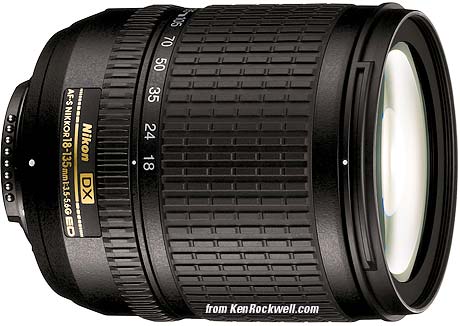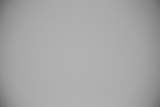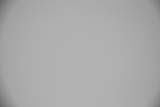|
I personally buy from Ritz, Adorama and Amazon. I can't vouch for any other ads.
|
Nikon 18-135mm
© 2006
KenRockwell.com
Nikon 18-135mm AF-S. enlarge
I ordered mine here. Here and here are also places from whom I would also buy personally. It helps me publish this site when you get yours from those links, too.
Top Specs Performance Recommendations
This 18-135mm lens is nice enough, but seems overpriced for what it is.
It works perfectly on every Nikon DSLR: D1, D1X, D1H, D2X, D2Xs, D2H/s, D50, D70, D70s, D80, D100 and D200.
It's sharp and agile, but I suggest saving your money for the spectacular Nikon 18-200mm VR (Vibration Reduction) which you know you really want. VR is important at longer focal lengths like 135mm. See Why VR Matters for examples. Without VR it's hard to get consistently sharp shots at 135mm due to camera vibration. Blurs that were invisible on film can be visible on today's 10 megapixel cameras.
The 18-200mm VR is not that much more expensive if you look at this over the space of a few years. As the saying goes, "the poor man pays twice," and I suspect you'll eventually want the 18 - 200mm VR which I greatly prefer.
If the 18-200mm isn't in your budget today, I suggest getting the inexpensive and excellent 18-55mm and selling it when you can get the 18-200mm.
An 18-135mm lens on a digital camera gives the same view as a 28-200mm lens does on a 35mm film camera.
This lens was announced 09 August, 2006. It sells for about $400 in the USA. Nikon knocks off $100 if you get it with the D80.
There's good news and bad news about this 18-135mm:
Bad News:
1.) It has a plastic bayonet mount. This isn't as bad as you'd think, since this lens is not likely to be mounted and unmounted very often.
2.) It lacks a focus scale, which confuses me. I always am looking at my focus scales.
3.) It has a lot of distortion, if you care.
4.) The distortion at the wide end can't be removed completely in Photoshop CS2's lens distortion filter.
4.) It has a lot of side color fringing at the very wide and telephoto ends of the zoom range which you will see in prints.
5.) Expensive for what you get.
6.) Zoom ring crowded at the telephoto end, making precise composition tougher than with the 18-200mm lens.
Good News:
1.) Very sharp.
2.) Light and compact; fast and easy to use.
3.) Real anytime instant manual focus override. Just move the focus ring!
Don't let me rain on any parades. The 18 - 135mm is going to be a very popular lens for many normal people who just want great photos. I suspect if you're curious enough to be reading this page that you'll probably appreciate the benefits of the 18-200mm VR as I do. The 18 - 200mm VR is enough to be the only lens I take everywhere, the 18-135mm is too much of a compromise for me.
If you're just looking for a decent lens, the much less expensive 18-55mm is just as sharp and perfect for general photos. Save your money and get something else with what you save.
ALPHABET SOUP EXPLAINED
Nikon calls this the Nikon AF-S DX Zoom-Nikkor 18-135mm f/3.5-5.6G IF-ED.AFS: Quiet focusing and instant manual focus override.
DX: Only works on digital cameras, not film.
ED: Magic glass for sharper images
G: No aperture ring. Only works on cameras newer than about 1992.
IF: Internal Focusing. Nothing moves on the outside of the lens when it focuses.
SWM: Silent Wave Motor for fast, quiet focusing.
All this and more explained in greater depth on my Nikon Lens Technology page.
Top Introduction Performance Recommendations
18 - 135 mm, similar to a 28 - 200 mm on a 35mm film camera.
f/3.5 - 5.6
Optics: 15 elements, 13 groups, including one ED glass element and two hybrid aspherical elements.
Diaphragm: 7 blade rounded, stopping down to f/22 - 38.
Filter Size: 67mm.
Close Focus: 1.5' or 0.45m from the image plane (the back of the camera). At 135mm the lens pops out, so your subject is only 9" (23cm) from the front of the lens while the back of the camera remains 1.5' from the subject.
Size: 2.9" x 3.4" (73.5 x 86.5 mm).
Weight: 13.510 oz. (383.1g), measured, naked.
Hood: HB-32, included.
Case: soft pouch, included.
Made In: Mine is made in Thailand. The front cap is from Thailand. The rear cap is from Japan.
Nikon Product Number: 2162, in catalog as of spring 2008.
Announced: August, 2006.
Shipping Since: September, 2006.
RATED MTF
Nikon has this to share from here:
at 18mm |
at 135 mm |
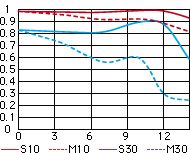 |
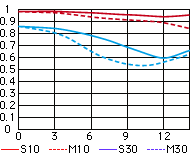 |
|
Top Introduction Specs Recommendations
Bokeh Distortion Falloff Film Flare Focus LCA Sharpness VR Zooming
BOKEH back to Performance. back to Introduction.
Bokeh (how out-of-focus areas look) is neutral, and pretty nice. I discovered this quite by accident photographing a kid. I explain Bokeh at my Bokeh page.
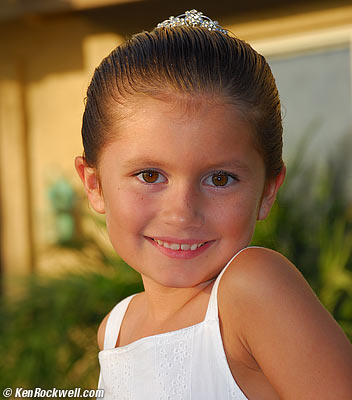
A Kid at 135mm, f/5.6 (slight crop).
Notice the nice, soft, undistracting background even though I wasn't careful about it.

A Dove at 15 feet, 135mm at f/8 (slight crop).
Again, a nice, undistracting background.
Bokeh Comparison: My Bokeh Comparison page shows examples of five other lenses to this 18-135mm.
DISTORTION back to Performance. back to Introduction.
Distortion is as bad as Nikon lenses get.
Even using Photoshop CS2's lens distortion filter you'll have residual waviness left over at the wide end, if you really care. The distortion is complex, which means it's not a simply bent curve and not easy to correct. You'll want a different lens or fancier software if distortion concerns you.
At 28 mm and above it corrects completely in Photoshop CS2's lens distortion filter without wavy lines. At 24mm and below you'll have some residual waviness after correction.
Here are the results of my research. More to come; this takes a lot of work! Plug these into Photoshop CS2's lens distortion filter to correct the distortion. These figures are for you to enjoy in your photography. This is all ©, so you'll need permission to re purpose this research for anything else. Thanks! Ken.
5' (1.5m) |
10' (3m) |
50' (15m) |
Infinity |
|
| 18 mm | +6.0 * |
+4.0* |
+4.0 ** |
+4.0 ** |
| 20 mm | 0 * |
-0.2* |
-0.5 * |
-0.5* |
| 24 mm | -2.2 |
-2.35* |
-2.5 * |
-2.5* |
| 28 mm | -4.0 * |
-4.0 |
||
| 35 mm | -4.0 |
|||
| 50 mm | -4.0 |
-4.0 |
||
| 70 mm | -3.25 |
|||
| 85 mm | -3.4 |
|||
| 105 mm | -3.4 |
|||
| 135 mm | -2.5 |
-2.5 |
* Some waviness remains, if you're looking for it.
** A good deal of waviness remains, if you're looking for it.
back to Performance. back to Introduction.
For portraits and many other subjects, falloff makes a better picture by concentrating the viewer's attention on the subject and away from the corners.
For photos of blank sky or brick walls it's bad.
This 18-135mm lens is normal. The only time it will be bad is if you're shooting something against a blank sky at 135mm at f/5.6. In this case you'll see darkening of the corners. If you like photographing birds in flight or aircraft you'll see this, but if you like these subjects, you want a longer lens anyway.
The falloff at 18mm wide open is almost never obvious because the sky or other objects themselves aren't evenly lit across this wide an angle. The falloff at 18mm is also more gradual, unlike the more abrupt darkening at 135mm..
If falloff bothers you, simply stop down a stop or two and it goes away.
Here are shots of an Expodisc. This is a tough test which shows even the slightest falloff. You'll almost never see this in normal photography. Ignore the minor exposure variations between frames.




